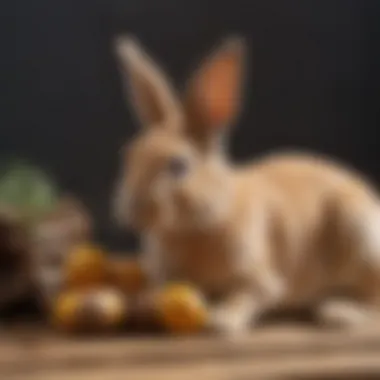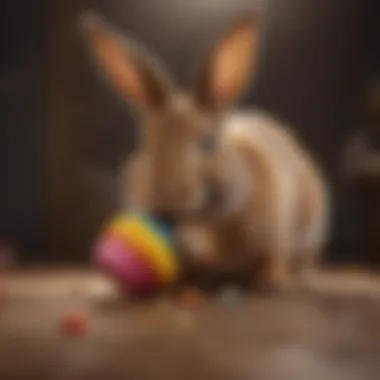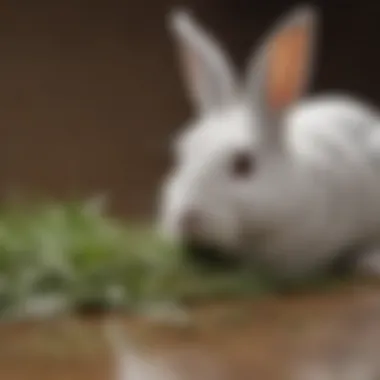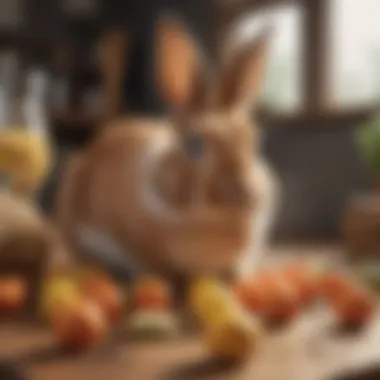Healthy Chew Options for Your Rabbit: Essential Guide


Intro
Understanding and fulfilling the needs of your pet rabbit goes beyond simple care. Rabbits are inquisitive creatures, and providing them with appropriate chewing options is essential for their dental health and overall mental stimulation. Chewing is a natural behavior that helps to keep their teeth healthy and prevent dental problems. By examining different chew options available, you can ensure that your rabbit not only maintains good dental hygiene but also enjoys engaging activities that enrich their life.
Understanding Your Pet
Pet Behavior Basics
Rabbits display a range of behaviors that reflect their health and mood. One important aspect is their natural instinct to chew. This behavior plays a role in wearing down their continuously growing teeth. An understanding of your rabbit’s behavior helps in selecting suitable chew items. If your rabbit exhibits excessive chewing on furniture or other household items, it may indicate boredom or a lack of appropriate chew toys. Encouraging healthy chewing habits is imperative for their well-being, both physically and mentally.
Common Breed Characteristics
Different breeds of rabbits may show varying preferences and needs. For instance, larger breeds such as Flemish Giants may benefit from more robust chew options due to their size. Conversely, smaller breeds like Netherland Dwarfs may prefer lighter chewable items. Understanding these characteristics allows you to choose the right chew products that fit their size and chewing strength.
Species-Specific Needs
Rabbits are herbivores, and their diets should consist of all-natural plant materials, which can include hay, leafy greens, and specific chewable items. Incorporating safe and nutritious chew options supports their dietary needs and promotes mental stimulation. It’s vital to research which materials are safe and appropriate for your rabbit's specific needs, as not all chewables are created equal.
Understanding the Chewing Needs of Rabbits
Rabbits are unique creatures that require specific care to thrive. Understanding their chewing needs is crucial for promoting health and well-being. Chewing is not merely a habit for rabbits; it plays a vital role in their dental health and mental stimulation. Ignoring these needs can lead to significant health issues, which affects their quality of life in the long term.
Importance of Chewing for Rabbits
Chewing is essential for several reasons. First, rabbits possess continuously growing teeth. In the wild, they wear their teeth down naturally by gnawing on various materials. This action prevents dental overgrowth, which can lead to painful conditions like malocclusion or other serious dental diseases. In short, providing appropriate chew items allows rabbits to maintain proper dental health.
Moreover, chewing serves a behavioral purpose as well. Rabbits are intelligent animals that need stimulation to keep them engaged. Chewing aids in channeling their energy positively and reducing boredom. It is a natural behavior that contributes to their overall mental health.
Additionally, the physical activity of chewing can contribute to gnawing muscles and promote jaw strength. This benefit extends beyond mere dental maintenance. Thus, pet owners must consider the variety and appropriateness of chew items they provide for their rabbits.
Consequences of Insufficient Chewing
If rabbits do not chew enough, the consequences can be severe. Insufficient chewing can lead to dental overgrowth. This can result in difficulties in eating, causing nutritional deficits. As a result, rabbits may experience weight loss and health deterioration. Furthermore, rabbits can develop painful abscesses or other dental issues that may necessitate veterinary intervention.
It is important to note that behavior changes can accompany physical health issues. A rabbit that cannot chew properly might exhibit signs of pain, such as lethargy or aggression. This highlights the importance of regular monitoring of their chewing habits and dental health. Pet owners should proactively offer suitable chew options to ensure their rabbits can access the necessary chewing experiences that align with their instinctual needs.
Natural Chewing Options
Natural chewing options are critical to a rabbit's health and well-being. These options not only satisfy their instinctual need to chew but also support their dental health. Chewing helps maintain the proper length of a rabbit's teeth and prevents dental problems. In this section, we will explore various natural materials that are safe for rabbits and can enhance their overall quality of life.
Safe Woods for Rabbits
Willow
Willow is well-known for its safety and suitability for rabbits. This wood is soft, making it easy for rabbits to gnaw. The important characteristic of willow is its fibrous structure. This structure encourages healthy chewing and helps wear down their teeth. Willow is especially popular because it serves as a natural stress reliever. Rabbits enjoy the texture and the taste of this wood, making it an excellent choice for chew toys.
One unique feature of willow is that it can often be found in various forms, such as sticks or branches. This variety gives rabbits options for different chewing experiences. However, overconsumption of willow can lead to digestive issues. Careful moderation is key.
Apple
Apple wood is another favorable option for rabbits. The prominent characteristic of apple wood is its delicious fragrance. The sweet smell appeals to many rabbits, adding to their chewing experience. Apple wood is a hard type of wood. It not only offers a satisfying chew but also adds variety to the rabbit's chewing routine.
One unique aspect of apple wood is that it is usually free from treated chemicals. This makes it relatively safe for consumption. However, the wood can be harder than softer types like willow, potentially posing a risk of splinters. Therefore, supervision while chewing is advisable to ensure safety.
Birch
Birch wood stands out in the realm of safe chewing options. The key characteristic of birch is its lightweight and slightly abrasive texture. This texture can help prevent dental issues and provide a satisfying chewing experience. Birch is also less likely to splinter compared to other harder woods.
A unique advantage of birch is its availability. It can often be found in pet stores or online specifically marketed as rabbit-safe chew items. However, it’s essential to avoid birch that has been treated with chemicals, as this poses health risks.


Herbs and Plants as Chewables
Basil
Basil is a favored herb among many rabbits for its aromatic qualities. The importance of basil lies in its dual role; it serves as both a chewable and a treat. Rich in flavor, basil encourages chewing, which is vital for dental health. Its texture is also appealing, making it an attractive option for rabbits.
Basil is beneficial in adding variety to a rabbit's diet. A unique feature is that it can be easily grown at home, ensuring a fresh supply for your pet. However, excessive amounts can lead to digestive issues, thus moderation is key.
Cilantro
Cilantro offers flavor and texture that many rabbits enjoy. It is another herb that supports chewing behaviors. The unique aspect of cilantro is its distinct aroma, which often attracts rabbits. Offering cilantro regularly can aid in providing mental stimulation and variety in their diet.
While cilantro is generally safe, it can cause some rabbits to experience mild digestive upset. Therefore, introducing cilantro gradually to your rabbit's diet is advisable.
Rosemary
Rosemary is a flavorful herb that also offers chewing benefits for rabbits. Its key characteristic is its robust texture, which appeals to many rabbits. Rosemary provides not just chewing satisfaction but also adds aromatic qualities for enrichment.
A unique advantage is that rosemary has potential health benefits, such as antioxidants. However, its strong flavor may not be preferred by all rabbits. Careful observation is essential when introducing rosemary into the diet.
Vegetables That Double as Chew Toys
Carrots
Carrots are not just a treat but also a great chew toy. The importance of carrots lies in their crunchy texture, which promotes chewing. This promotes dental wear that rabbits need. Carrots also provide essential nutrients and hydration, making them a versatile snack.
A unique feature of carrots is that they can be used in both raw form and as a dried chewable. However, they should be offered in moderation due to their higher sugar content.
Celery
Celery is often overlooked but serves as an excellent chewable. Its fibrous texture makes it appealing to rabbits. Moreover, it is high in water content, which is beneficial for hydration.
Celery's unique aspect is its crunchy structure, which can help keep teeth healthy. However, rabbits should be introduced to celery slowly, as some may experience digestive issues if offered too much.
Bell Peppers
Bell peppers provide both crunch and color to a rabbit's diet. Their key characteristic is their higher vitamin content, particularly Vitamin C, which is essential for overall health. Many rabbits enjoy the sweet and crisp nature of bell peppers, making them an appealing chewable.
One unique feature of bell peppers is that they come in various colors, offering an attractive visual aspect. However, they should be introduced in moderation to ensure that they do not disrupt a balanced diet.
Each of these natural chewing options enriches a rabbit's experience. Understanding the unique qualities and care considerations of these items ensures that pet owners can choose safe, enjoyable chewables for their rabbits effectively.
Commercially Available Chew Items
Incorporating commercially available chew items into a rabbit’s diet is essential to both physical health and enrichment. These products often meet specific standards for safety and accessibility, providing pet owners with the assurance that they are not exposing their rabbits to toxic materials. By choosing these products, owners can provide options that encourage healthy chewing while also keeping dental health in check. The variety of chew items available also helps to engage a rabbit's natural instincts, adding both stimulation and enjoyment to their environment.
Rabbit-Safe Chew Toys
Wooden Chew Toys
Wooden chew toys serve as an excellent - and often logical - choice for rabbits. They are made from natural, untreated woods that provide essential wear for a rabbit's constantly growing teeth. The texture and density of wood can vary, providing different experiences for the rabbit.
Key characteristic: The primary advantage of wooden chew toys is their ability to be safe and durable. They do not contain harmful chemicals that can often be present in man-made materials.
One unique feature of wooden chew toys is their potential to be flavored, such as those infused with herbs, which can engage your rabbit even further. However, it is crucial to monitor how much chewing occurs, as excessive gnawing may lead to splinter issues.
Natural Fiber Toys
Natural fiber toys are an alternative that also caters to the chewing habits of rabbits. Made from grasses or other natural fibers, these toys are soft yet durable. They promote dental health while also providing a texture that is appealing to rabbits.


Key characteristic: The soft and gentle nature of natural fiber makes them less harsh on teeth than some wooden products.
A notable aspect of these toys is their biodegradable nature, contributing positively to environmental sustainability. Even though they are generally safe, they can wear out faster than wooden options, requiring more frequent replacements.
Chew Treats and Their Benefits
Timothy Hay Cubes
Timothy hay cubes are a staple in many rabbit diets. They offer fiber that is crucial for digestive health. The concentration of nutrients in these cubes can also promote overall well-being.
Key characteristic: High fiber content is one of the significant benefits of Timothy hay cubes. They can assist in preventing dental problems.
The form of cubes allows for easier handling and consumption by rabbits, which can be helpful for those who may be picky eaters. However, it is important to ensure that they are stored correctly to prevent mold growth.
Dried Veggies
Dried veggies can be a flavorful addition to a rabbit’s chewables. They provide variety while maintaining important nutrients that keep rabbits healthy. Different vegetables can be dried and served as treats, allowing for diversity in taste.
Key characteristic: The intense flavors and textures of dried veggies can encourage chewing behavior. They serve as effective rewards during training or activities.
However, over-reliance on dried treats can lead to an unbalanced diet if they are not used sparingly. It’s essential to offer fresh vegetables as well, maintaining a diverse and balanced eating plan.
Choosing safe and healthy commercially available chew items is a fundamental step in responsible rabbit ownership. Understanding their nutritional and behavioral needs is key to providing a thriving environment for your pet.
Preparing Homemade Chew Options
Creating homemade chew options for your rabbit is a rewarding practice that can contribute significantly to your pet's dental health and mental stimulation. While there are plenty of commercially available items, preparing chewable treats at home gives you the ability to control the ingredients. This ensures that only safe and beneficial components are used, which is crucial for your rabbit's health. Moreover, the act of preparing these chewables can help reinforce the bond between you and your pet, adding an additional layer of engagement to their care.
Choosing Safe Ingredients
Selecting safe ingredients is the foundation of any homemade chew option. Not all plants and materials are suitable or safe for rabbits. Therefore, understanding which items are beneficial is essential. Here are a few key elements to consider:
- Avoid toxic plants: Knowledge of harmful plants is critical. Some examples include nightshade species, certain lilies, and many ornamental plants which can be toxic to rabbits.
- Use fresh herbs: Herbs like basil, parsley, and cilantro are excellent choices. They provide flavor, and nutrients, and are safe for rabbits to chew.
- Fresh vegetables: Non-starchy vegetables can be good options as well, adding variety and nutrition.
Prioritizing safety will ensure that the chew options you create are not only enjoyable for your rabbit but also health-conscious.
Simple Recipes for Rabbit Chewables
Creating simple recipes provides an easy way to make engaging chew options. Two popular treats you can make are Herb Wands and Vegetable Chews.
Herb Wands
Herb Wands are great chewables for rabbits that combine fresh herbs with an easy-to-handle stick. These wands allow rabbits to munch on their favorite herbs while simultaneously satisfying their chewing instinct.
Key characteristic: Herb Wands are made by attaching herbs like basil and dill onto a small, chew-safe stick. This allows rabbits to enjoy their natural grazing behavior.
Benefits: Herb Wands are popular because they provide flavor and nutrition. The act of chewing herbs also promotes dental health, making them an ideal choice. Plus, they are visually appealing and can make feeding time more enticing.
Vegetable Chews
Vegetable Chews offer a different texture and taste experience. They can be made from various safe vegetables that your rabbit enjoys, such as carrots or bell peppers.
Key characteristic: Vegetable Chews are typically sliced into manageable pieces that allow rabbits to nibble comfortably. This encourages chewing while providing nutrition.
Advantages: These chews are not only enjoyable but also contribute vitamins and minerals that are essential for your rabbit's well-being. However, it's important to monitor the amount given, as too much can lead to digestive issues.
Remember: Always introduce any new chew option gradually to monitor for any adverse reactions.
In summary, preparing homemade chew options can greatly enhance your rabbit's chewing experience while ensuring safety and health. By carefully choosing safe ingredients and employing straightforward recipes, you can create enriching and enjoyable treats for your fluffy companion.


Safety Considerations
Safety is a crucial factor when selecting chew options for your rabbit. Understanding what materials and plants can be harmful is vital for preventing health issues. Uncontrolled chewing can lead to digestive problems or even poisoning if your rabbit consumes toxic items. Thus, evaluating chewable materials before offering them to your pet is essential. Rabbit owners must arm themselves with knowledge about safe choices. This vigilance ensures the rabbit’s dental health does not come at the expense of overall well-being.
Identifying Toxic Plants and Materials
Rabbits are curious creatures, and they might nibble on various plants and materials that are not safe. Some common plants pose significant risks. For example, you should keep your rabbit away from certain houseplants like azalea, yew, and holly. These plants can cause severe gastrointestinal distress or worse if ingested.
In addition to plants, certain woods are also unsafe. Avoid treated woods, as chemicals used in treatment can be toxic. Never use materials like plastic or rubber for chewing. These can lead to choking or internal blockage. Instead, focus on safe items such as untreated wood from willow, apple, or birch. Understanding the ins and outs of safe materials protects your rabbits from potential harm.
Safe vs.
Toxic:
- Safe Chewing Options:
- Toxic Plants:
- Untreated natural wood
- Certain herbs like basil and rosemary
- Fresh vegetables like carrots and bell peppers
- Azalea
- Yew
- Holly
Having a list of safe and toxic items can simplify the selecting process.
Signs of Chewing Safety Risks
Awareness of your rabbit's behavior is key in identifying potential safety risks. Watch for signs that might indicate your rabbit is gnawing on dangerous materials or plants. First, monitor for changes in appetite or energy levels. If your rabbit suddenly shows a lack of interest in food or play, it could be a red flag.
Another sign to observe is gastrointestinal upset. Symptoms like diarrhea or unusual feces can indicate that your rabbit has consumed something harmful. Additionally, pay attention to any changes in chewing habits. If your rabbit changes its chewing behavior, it might be worth investigating further. Always be proactive in your care, as timely intervention can prevent severe health issues.
In summary, understanding safety considerations allows rabbit owners to create a safe environment. You should consistently educate yourself about plants and materials that pose risks. The investment in this knowledge pays off in healthier and happier rabbits.
Integrating Chewing into Daily Routine
Integrating chewing into the daily routine of your rabbit is essential for maintaining its overall health and well-being. Chewing serves several important purposes that go beyond mere enjoyment for these animals. Engaging in chewing activities can help maintain dental health, alleviate boredom, and encourage natural behaviors. For pet owners, understanding how to effectively incorporate chewing into their rabbit's day can lead to a happier and healthier pet.
Encouraging Healthy Chewing Habits
Establishing routines that promote healthy chewing habits is crucial. Rabbits naturally need to chew to wear down their teeth, which continuously grow throughout their lives. Providing a variety of chew options can prevent dental issues, such as overgrown teeth. It is vital to ensure that these chew items are safe and suitable for your rabbit. Regularly observe your rabbit's preferences; some may enjoy wooden toys, while others may prefer herbs or dried vegetables.
- Introduce a variety of chewables: Rotate between different types of chew options, such as woods, herbs, and vegetables. This keeps their interest alive and promotes exploration.
- Create a consistent schedule: Establish a specific time during the day dedicated to chew activities. This can create anticipation and encourage your rabbit to enjoy the activity more.
- Monitor usage: Observe how long your rabbit spends chewing each day to ensure they are getting enough activity and variety in their diet.
Alternative Activities to Support Chewing
In addition to providing chew items, consider incorporating activities that naturally encourage chewing behaviors. These can stimulate your rabbit mentally and physically.
- Hide chewables in their environment: Placing chew toys or edible items around the living space encourages your rabbit to explore. They will need to search for their treats, which promotes physical movement.
- Interactive feeding: Use chewable treats as rewards during play. This encourages your rabbit to work a bit for their snacks, simulating natural foraging behavior.
- DIY chew toys: Consider making your own chew items using safe materials. Simple combinations of herbs and vegetables can serve as enriching chewables that your rabbit may find exciting.
Chewing is not just a pastime; it’s a crucial part of a rabbit's health. Fostering an environment rich with chewing options aligns with their natural instincts.
In summary, integrating chewing into your rabbit’s daily routine involves offering a variety of safe and enriching chew options while also encouraging playful interaction. This not only supports their dental health but also enriches their life, making them more engaged and happy.
Finale
Summarizing the Importance of Chewing
Chewing plays a critical role in a rabbit's health and behavior. This activity is not merely a fun pastime; it is essential for maintaining dental health. Rabbits have continuously growing teeth, which must be worn down through regular chewing. Enhanced dental health reduces the risk of dental issues, leading to a happier and healthier life for the rabbit. Furthermore, chewing satisfies a rabbit’s instinctual behaviors, providing mental stimulation that can be beneficial to their overall well-being.
In addition to physical enhancements, chewing offers behavioral enrichment. By engaging with a variety of chew options, rabbits can reduce boredom and prevent destructive tendencies. Offering diverse and safe chew materials creates a stimulating environment that nurtures their natural instincts. Thus, a comprehensive understanding of suitable chew items reinforces responsible pet ownership and ensures that rabbits can thrive in their home environments.
Next Steps for Rabbit Owners
As a rabbit owner, implementing the insights from this article is pivotal. First, assess the chewing habits of your rabbit. Observe which types of materials your rabbit consistently engages with and modify their options accordingly. Consider the following steps:
- Diversify Chew Options: Introduce both natural and commercially available chewables to your rabbit's environment. Natural wood, safe plants, and specialized chew toys should all be part of their selection.
- Monitor Chewing Behavior: Pay attention to your rabbit's preferences and any changes in their chewing habits. Such observations can inform if adjustments are needed in the types of chew items provided.
- Ensure Safety: Regularly check the chew items for signs of wear, and ensure none of the materials are toxic. Familiarize yourself with safe materials and identify any harmful substances to avoid.
- Create a Routine: Incorporate chewing into your rabbit’s daily activities. Set aside specific times for them to enjoy their chewables, making it a regular part of their schedule.
By following these steps, you can contribute to your rabbit's dental health and overall happiness. Engaging in this way promotes not just physical health but also enhances the bond between you and your pet.







